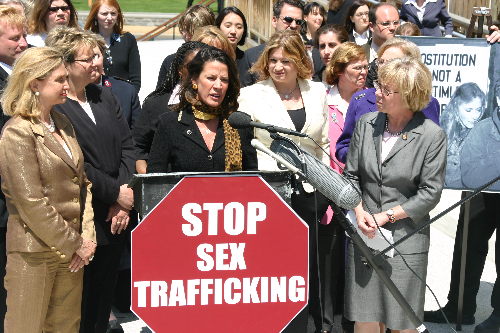
This post was created in collaboration with the Minnesota Journalism Center.
Recent estimates from the International Labor Organization (ILO) and Walk Free Foundation found that more than 40 million people are in modern slavery. The ILO has valued human trafficking as a $150 billion industry, with $99 billion coming from commercial sexual exploitation. Prostitution and trafficking are both illegal in America (except for several counties in the state of Nevada where prostitution is legal), but the two terms are often conflated. With regard to terminology: When one is coerced or forced into selling themselves for sex, it is a form of trafficking, and those who enter the regulated sex industry voluntarily are deemed sex workers.
The “normalization” of sex work worldwide is still in flux. Scholars divide the international community into two camps with regard to this issue: abolitionist feminists, who believe both voluntary and involuntary prostitution and sex work is exploitative; and human rights feminists, who de-link prostitution/sex work and trafficking by arguing that some adult women and men are in prostitution/sex work voluntarily and should not be considered victims, and only those who are forced or coerced to be prostitutes or sex workers should be considered trafficking victims.
- Orlando Patterson and Xiaolin Zhuo. 2018. “Modern Trafficking, Slavery, and Other Forms of Servitude.” Annual Review of Sociology 44(1): 407-439.
- Noël Bridget Busch-Armendariz, Maura Nsonwu, and Laurie Cook Heffron (Eds.). 2017. Human Trafficking: Applying Research, Theory, and Case Studies. Los Angeles: SAGE.
- Mark P. Lagon. 2017. “Reflections on Global Justice and American Exceptionalism.” World Affairs 180(1): 42–63.
- Amy Farrell and Shea Cronin. 2015. “Policing Prostitution in an Era of Human Trafficking Enforcement.” Crime, Law and Social Change 64(4–5): 211–228.
- Elizabeth Bernstein. 2010. “Militarized Humanitarianism Meets Carceral Feminism: The Politics of Sex, Rights, and Freedom in Contemporary Antitrafficking Campaigns.” Signs: Journal of Women in Culture & Society 36(1): 45–71.
Scholars demonstrate that NGO coverage of trafficking often portrays “ideal victim” and “ideal perpetrator” stereotypes that don’t always reflect the truth about who is subject to trafficking worldwide. Further, journalistic coverage of trafficking is often written through the lens of “episodic” frames that provide personal narratives but lack trend statistics, quotes from experts, or social forces at play in perpetuating demand for trafficking worldwide.
- Meghan Sobel, Barbara Friedman and Anne Johnston. 2017. “Sex Trafficking as a News Story: Evolving Structure and Reporting Strategies.” Journal of Human Trafficking: 1–17.
- Erin O’Brien. 2016. “Human Trafficking Heroes and Villains: Representing the Problem in Anti-Trafficking Awareness Campaigns.” Social & Legal Studies 25(2): 205–224.
- Girish J. Gulati. 2011. “News Frames and Story Triggers in the Media’s Coverage of Human Trafficking.” Human Rights Review, 12(3): 363–379.
As anti-trafficking campaigns evolve in the Digital Age, technology also plays an integral role in efforts to curb demand and address supply that flows through social media networks and the Internet. Initiatives — including research about online demand for sex and working partnerships between social scientists, law enforcement, and anti-trafficking NGOs — are shaping the future of anti-trafficking efforts worldwide.
- Artur Dubrawski, Kyle Miller, Matthew Barnes, Benedikt Boecking and Emily Kennedy. 2015. “Leveraging Publicly Available Data to Discern Patterns of Human-Trafficking Activity.” Journal of Human Trafficking 1(1): 65–85.
- Jennifer Lynne Musto and danah boyd. 2014. “The Trafficking-Technology Nexus.” Social Politics: International Studies in Gender, State & Society 21(3): 461–483.
- Mitali Thakor and danah boyd. 2013. “Networked Trafficking: Reflections on Technology and the Anti-trafficking Movement.” Dialectical Anthropology 37(2): 277–290.

Comments